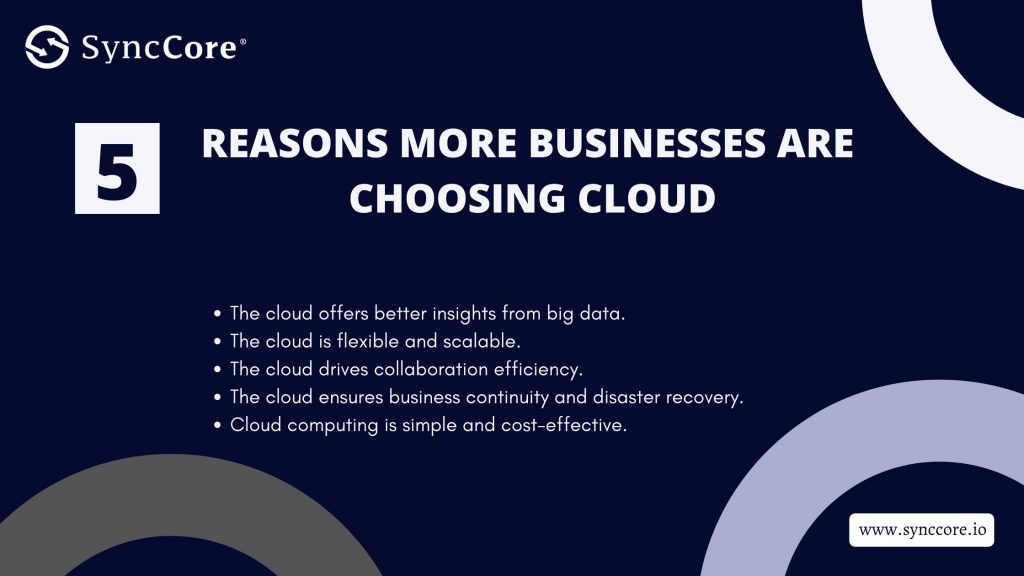Table of Contents
Top 5 Reasons More Businesses Are Choosing Cloud

According to a survey by 451 research, if you are still debating whether or not to embrace cloud migration in 2020, you will have already fallen behind 90% of enterprises. The majority of these businesses also employ a multi-cloud strategy. This means that cloud adoption has reached a tipping point, with the great majority of enterprise workloads now residing on the cloud.
There are numerous reasons why businesses prefer the cloud to traditional computing and data storage methods. Like any other new technology, Cloud migration has some risks and drawbacks. However, the advantages far exceed the liabilities.
Here are some practical reasons cloud migration is a good choice for businesses of all sizes.

The cloud offers better insights from big data.
Businesses generate massive amounts of organized and unstructured data every day, referred to as big data. According to an Accenture poll, 79 percent of organizations believe that enterprises that do not embrace big data risk losing their competitive edge and potentially going extinct.
Obtaining relevant insights from extensive data necessitates cost-effective data processing methods. In the long run, your on-premises storage systems may be unable to keep up with high-volume data creation. Even if you try to do everything the old way, you’ll need to invest heavily in your infrastructure to make it work.
Most significantly, your on-premises data warehouse may not be capable of supporting modern analytics tools that analyze data quickly. You may obtain essential insights from your data and make data-driven decisions by going to the cloud.
The cloud is flexible and scalable.
Scalability is one of the critical advantages of using the cloud. Many firms in the early stages of development have turned to the cloud to handle their bandwidth needs. Cloud services can quickly scale up or down in response to customer demand. To scale up your growing firm, you’ll need to invest considerably in physical servers, networking equipment, and software licensing if you exclusively employ on-premises infrastructure.
Cloud services are also incredibly adaptable. They don’t bind your employees to a single location. Access and share crucial documents for strategic corporate decision-making from any internet-enabled device, such as laptops, cellphones, or notebooks. In a crowded market, businesses require this level of adaptability to thrive.
During the Covid-19 pandemic, the benefits of cloud computing were evident to all. In comparison to their non-cloud counterparts in the same industry, businesses on the cloud could adjust to the new remote working norms considerably faster and more efficiently.
The cloud drives collaboration efficiency.
Cloud computing can also improve the productivity of numerous firms’ work processes. Cloud technology allows individuals to collaborate on a much bigger scale. It enables several users from various departments to access the necessary data.
Businesses can use cloud technology to bypass regional limitations and create a multi-region infrastructure that can be accessed anywhere. This improves collaboration efficiency among international teams and leads to business growth.
Businesses that mix cloud technology with managed services may communicate information more efficiently, reduce human error, and accelerate decision-making. This allows them to increase productivity by focusing on the most critical tasks.
The cloud ensures business continuity and disaster recovery.
How organizations store and access data has changed thanks to the cloud tremendously. This is especially useful when firms need to recover rapidly after a natural disaster. According to research by The Diffusion Group, 60 percent of organizations that experience irrecoverable data loss close down within six months after the disaster.
With the threat of ransomware and physical harm looming, businesses need something they can rely on in the event of a tragedy. Cloud backup enables businesses to swiftly recover their data, allowing them to continue operating without interruption. Companies that wish to survive and remain competitive after a data loss catastrophe must minimize downtime.
Even during the current pandemic, the cloud has enabled businesses to remain operational and conduct business from any location.
Cloud computing is cost-effective and straightforward.
Scaling your on-premises infrastructure is a costly endeavor. Additional hardware, network equipment, software licenses, and in-house technicians are required. When you consider maintenance and installation fees, these expenditures skyrocket. Infrastructure is also vulnerable to physical damage caused by calamities such as floods and fires.
When you move to the cloud, you can get rid of your redundant infrastructure investment. Although cloud computing requires initial setup and training, it allows you to reach economies of scale considerably more quickly than on-premises infrastructure. One of the primary reasons businesses worldwide prefer the cloud to traditional systems is cost.
It’s time to get cloud-ready.
When moving to the cloud, it’s critical to have clear cloud adoption policies to guide your employees and ensure they have the training to utilize the technology properly. If this is your first time, you should plan your cloud adoption in stages to ensure that it fully integrates with your company’s infrastructure. Most importantly, you must identify the obstacles you are likely to face, such as bandwidth issues, legacy programs, data compatibility, and so on, as well as viable solutions.
You must understand that cloud projects are complex, and developing the requisite skillsets for all functionality involved may take some time. However, you may successfully become a cloud-first organization by carefully evaluating your strategy and continuously improving your cloud adoption activities.
You risk falling behind your competitors and losing your competitive edge in today’s market if you don’t move to the cloud. You can build a long-term growth strategy and future-proof your company with a solid cloud strategy.
Read More:
6 Tips for Choosing the Right Cloud for Your Business in India



